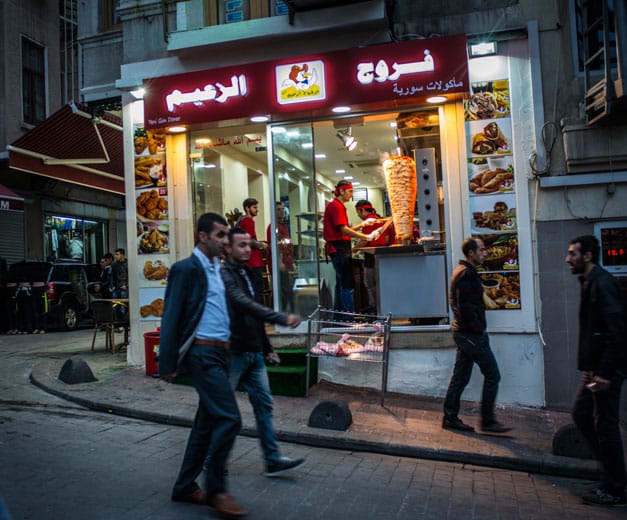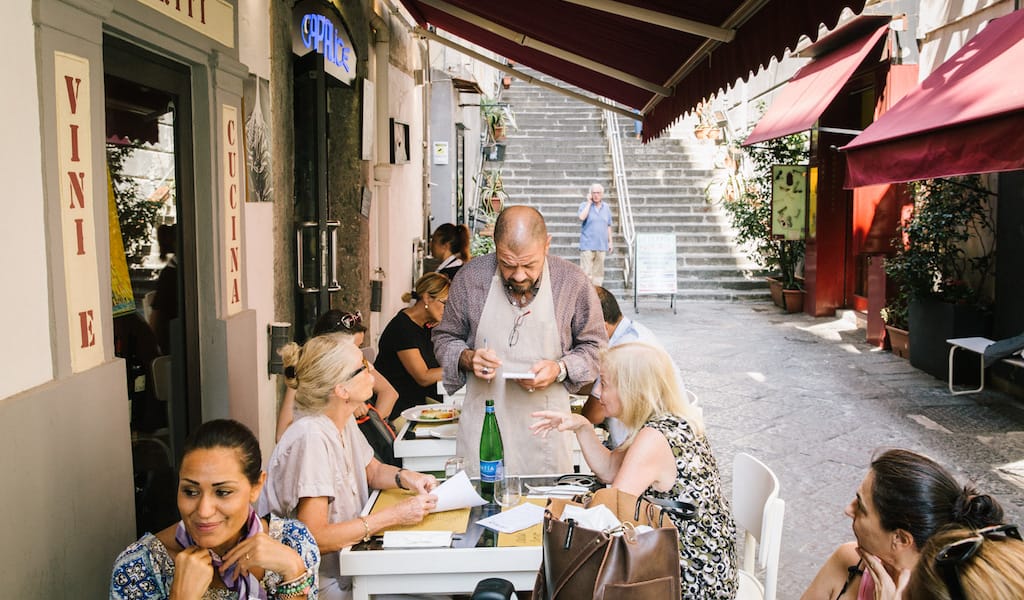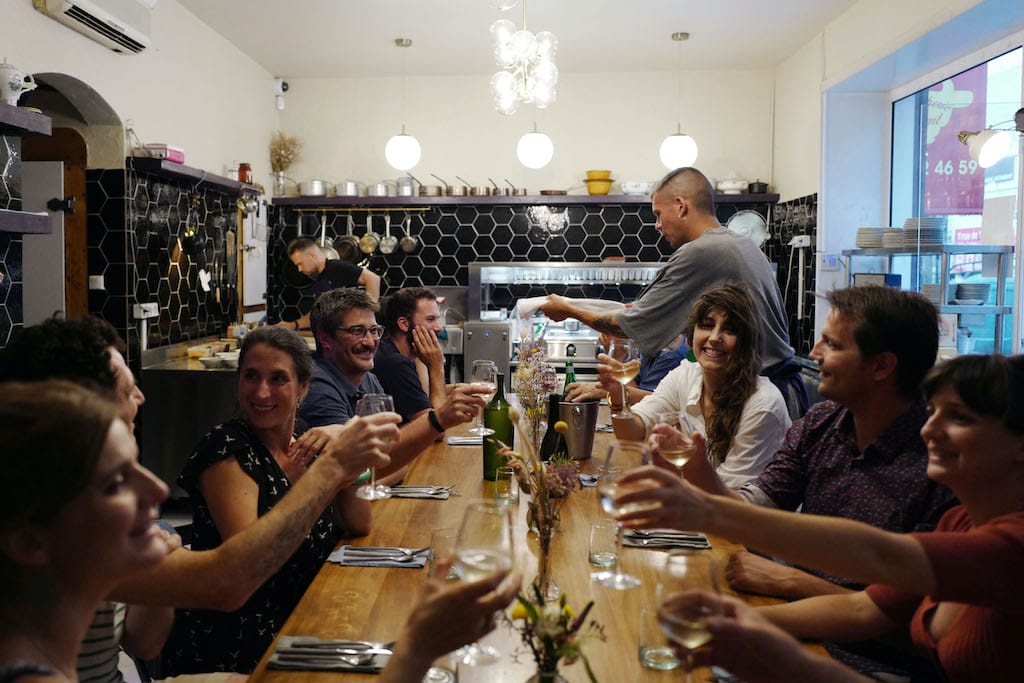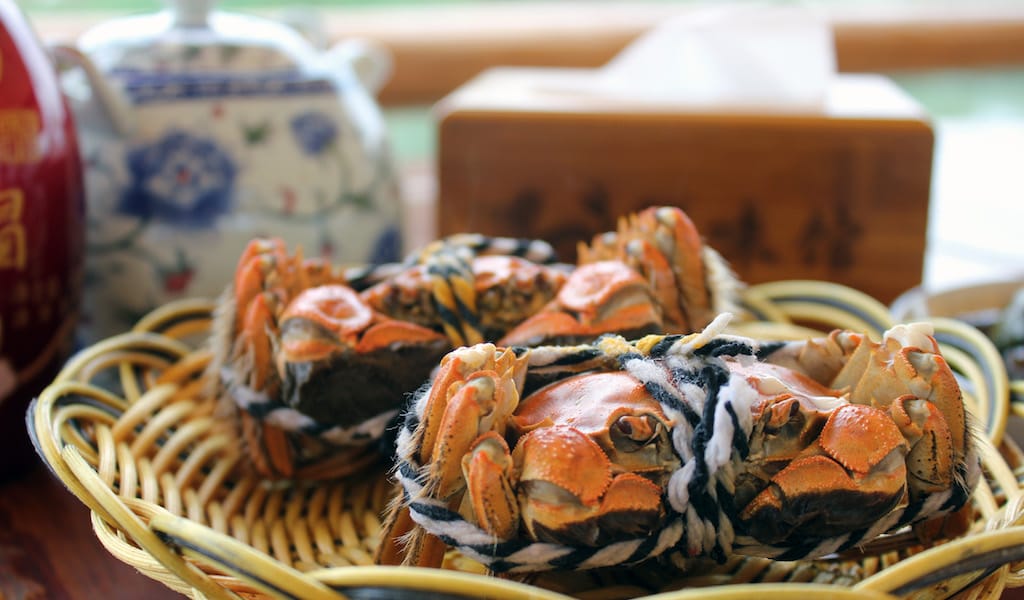Editor’s note: We regret to report that Farooj al Zaeem has closed.
Farooj al Zaeem is, pretty much, the best kind of restaurant made to resemble the worst kind of restaurant. If the neighborhood – one of Beyoğlu’s most unkempt snatches – doesn’t send you running, then the look of this place, like a knockoff polo shirt with misspellings, will signal that something here is not right.
Despite the wall of pre-folded fried chicken takeout boxes and all the signage dedicated to the house specialty, no one comes to this Syria-based chain without wiping a thin triangle of fresh pita through a few of the Syrian specialties, which are all executed so well here. Though the whole vibe of the place – cramped interior, cartoony sheriff rooster logo, uniformed staff, enlarged food photos with a corporate sheen – would tell you otherwise, this is actually a place where Syrians come to get proper, freshly made food that tastes like home. Zaeem is so authentically Syrian that some just pass through to say hello the Syrian way, a quick handshake and a kiss of the fingers.
With great interest, we’ve tracked the rise of Syrian restaurants in Istanbul, mainly in the Aksaray district. But not until Zaeem did we have that what-have-I-been-missing feeling that usually inspires us to try copying the food at home and, failing that, become a regular of the place. Zaeem’s signature move is a very generous application of garlic, tahini and lemon.
Let’s face it: Turkey lies well north of the world’s hummus belt. The Middle Eastern linchpin of chickpeas, garlic, lemon, oil and tahini does not resonate here. Turks will tell you: This is not the Middle East. Exhibit A? Bum hummus. Zaeem’s hummus was ultrasmooth, with a tahini-centric, garlicky smack, looking vaguely like something you might find on a meze tray around town but tasting entirely exotic.
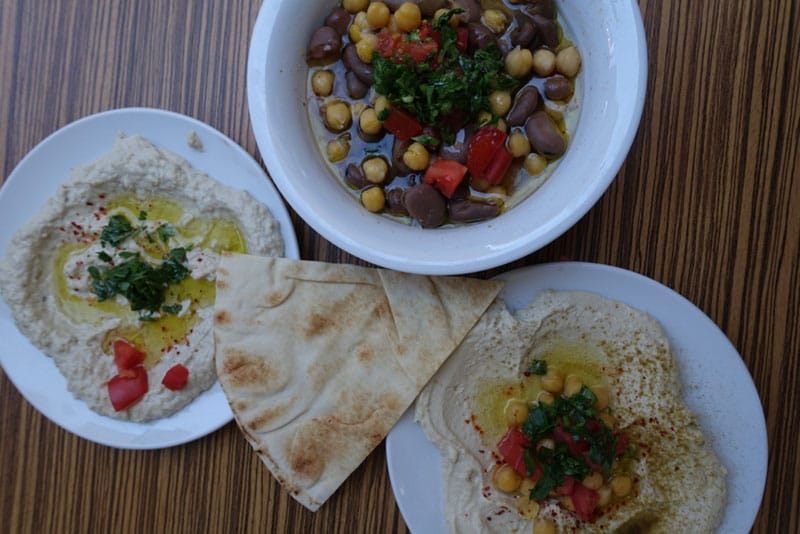
The chicken shwarma is another case of mistaken identity. We expected nothing much more than the same tavuk döner sold at corner shops all over the neighborhood. This one had a different spicing and a powerful lemony tang. We solicited the dönerci, Muhammed, from the city of Homs, for more information on the marinade, but he would only tell us that there were “12 to 16 spices” used. But it would be unfair to give all of the credit to the shwarma; equally seductive was the toum krem, a house-made garlic mayonnaise (which stands at a close second behind Greek tzatziki in the category of greatest condiments for döner-style sandwiches), which we lathered on every bite.
Mutabbal added the element of smoky mashed eggplant and yogurt tang to the previously noted trio, while ful, plump fava beans topped off with chickpeas, was more focused on the bright lemon and garlic side of the story. All were garnished artfully with chopped tomato and parsley.
The fetteh, Zaeem’s pièce de résistance, was topped with deep-fried pita chips and peanuts on one occasion and nude on another. Turning around to ask what happened to the topping, we were nearly scalded as a cook sauntered over to pour sizzling clarified butter on our fetteh. Fetteh is a layered dish, and, fried pita aside, the textural differences between those layers can be very subtle – yet crucial to fully enjoying fetteh, so please don’t go churning up your fetteh with a spoon like it’s a bowl of common mercimek çorbası. Fishing from the bottom of the strata, we drew up chicken broth-soaked bread and shreds of soft chicken coated in a tahini-yogurt sauce that hung around the top. Going shallow, we found a pocket of chickpeas under the sauce and snagged a pita chip from the surface. Please pay attention: There are 1,001 unique bites in this monochromatic bowl.
The standard against which we measure all fetteh was a heaping bowl we had years ago at a simple lunch spot in Damascus. We can’t recall how every bite of that fetteh went, but the lasting memory is of a dish that that crosses the best elements of chicken soup with those of hummus, and Zaeem’s presentation was all that.
Befuddled by the apparent care and utter unfastfoodness each dish was made with, we pressed the kitchen for answers. Muhammed, a waiter from the Syrian port of Latakia, told us that this was in fact a Syrian chain with a location in Ain Tarma and one in Yarmouk. “It is quite typical Syrian fast food,” he said in perfect English. Leaving us with one more serious question: Did they miss the memo on fast food or did we?
Does a chain restaurant have to represent everything that’s wrong with the processed food world and its evil industries? Did this directive never reach Syria? The boys at Zaeem don’t think there’s anything strange about making fresh food fast in a Chick-fil-A-like setting. If the food is good, who cares?
That’s inspiring. We only hope that peace will one day settle over the hummus belt so we might test this theory.
 September 19, 2019 Cap’alice
September 19, 2019 Cap’alice
The seaside district of Chiaia, perhaps best known for Via Caracciolo, a boulevard with […] Posted in Naples July 8, 2022 Camas Sutra
July 8, 2022 Camas Sutra
The storefront restaurant Camas Sutra (a play on its location in the Camas neighborhood […] Posted in Marseille September 30, 2021 Harvest Week
September 30, 2021 Harvest Week
In the sections of China’s Jiangsu Province where Huaiyang cuisine reigns supreme, […] Posted in Shanghai
Published on October 27, 2014
Related stories
Taste the best Campania products on our Naples walk!
September 19, 2019
NaplesThe seaside district of Chiaia, perhaps best known for Via Caracciolo, a boulevard with sweeping views of the Bay of Naples, is the most elegant neighborhood in Naples. Long the seat of the Neapolitan aristocracy, the area is studded with Art Nouveau palaces, elegant boutiques, and Villa Pignatelli, a house museum with an impressive art…
July 8, 2022
Marseille | By Jenine Abboushi
MarseilleThe storefront restaurant Camas Sutra (a play on its location in the Camas neighborhood of Marseille) still sports “Boucherie, Charcuterie, Crèmerie” on the original red and yellow banners, left over from just 18 months ago when it was home to a neighborhood butcher. The “no restaurant sign” tactic, occasionally seen these days in hip neighborhoods…
September 30, 2021
ShanghaiIn the sections of China’s Jiangsu Province where Huaiyang cuisine reigns supreme, autumn is marked not by yellow and red foliage or falling temperatures. The change in seasons instead comes when restaurants post hairy crab (大闸蟹 Dàzháxiè) menus and shops selling baked goods the rest of the year pivot to aquariums full of the live…







































